FEATURES|COLUMNS|The Shugendo Diaries
Connecting the Past and Present of Shugendo – The Revival of Japan’s Ancient Mountain Ascetic Tradition, Part One
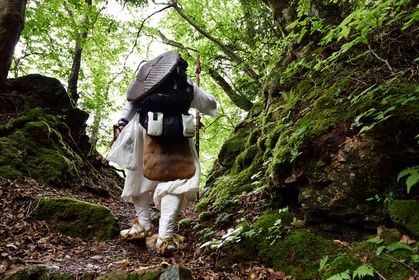
The yamabushi outfit, each part of which has a deep meaning.
Photo by Banri Tanaka
They appear to belong to a different time and a different place. Robed from head to toe in archaic costumes, their feet bound in straw sandals, animal furs on their hips, and little black caps atop their foreheads. They blow horagai (a conch shell instrument) while traversing some of the remotest trails on the most sacred of Japan’s mountains. These are Shugenja, followers of Shugendo, a spiritual tradition with roots in Japan’s ancient past.
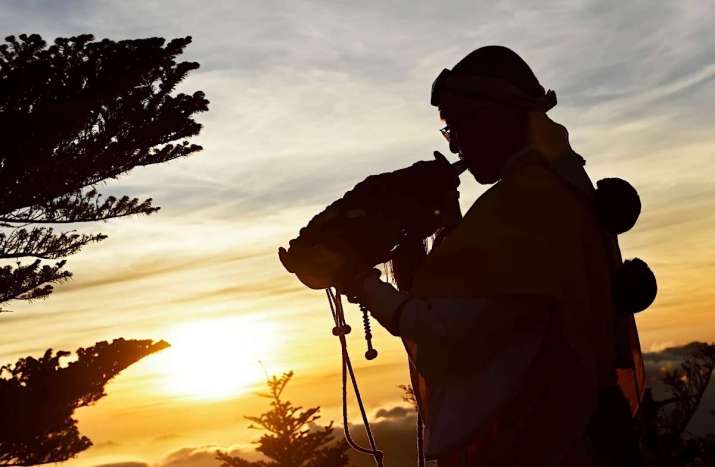 A Shugenja playing the horagai in the mountains. The conch shell is an important tool for practitioners. Photo by Banri Tanaka
A Shugenja playing the horagai in the mountains. The conch shell is an important tool for practitioners. Photo by Banri TanakaLiterally, Shugendo means “the path of training and testing to achieve special powers.” Shugenja are popularly known as yamabushi, a term which translates as “one who lies in the mountains.” This hints at the hermit-like life of practitioners who once took up residence in the mountains.
Their ultimate goal is to attain enlightenment and to acquire special powers that enable them to conduct acts of healing, purification, and exorcism to their own benefit and to benefit the communities in which they live. Traditionally, Shugenja became mediators between the spiritual realms and the human sphere as villagers sought their help in both religious and more mundane matters.
This religious tradition is about 1,300 years old, but it received a fatal blow when Japan evolved from its feudal period to modern times during the Meiji period (1868–1912). Shugendo was banned and most of the sites associated with its practice ceased to exist. In recent decades, however, some former Shugendo places have seen a revival as more and more localities have become interested in discovering their spiritual past.
This article provides a short history of Shugendo and examines the elements that will need to be in place to make a revival possible, namely: people, practices, places.
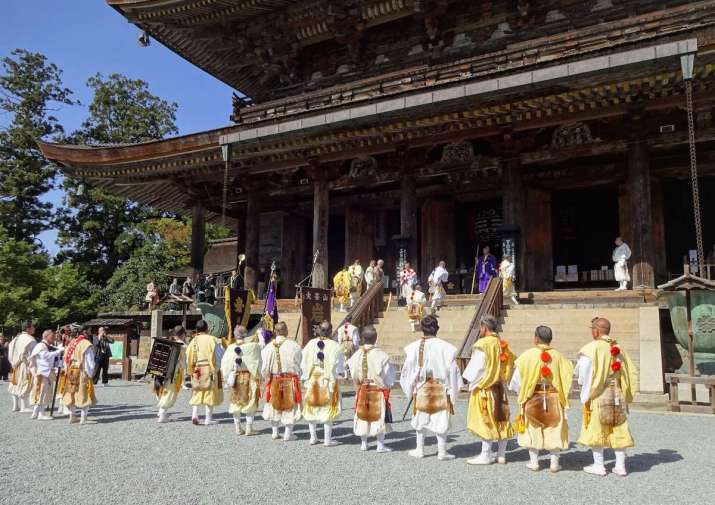 A group of Shugenja at the Zao Hall of Kimpusen-ji in Yoshino. Zao Gongen is an important deity worshipped by yamabushi here. Photo by Alena Eckelmann
A group of Shugenja at the Zao Hall of Kimpusen-ji in Yoshino. Zao Gongen is an important deity worshipped by yamabushi here. Photo by Alena EckelmannThe roots and rise of Shugendo
Since ancient times, the Japanese have considered mountains to be sacred and the seat of kami, or Shinto deities. Mountains were also seen as frightening places because ancestral spirits, the souls of the dead, and oni (demons) were likewise thought to dwell there. It was only after Buddhism and Taoism came to Japan in the sixth century that practitioners used mountains for ascetic training purposes.
En no Gyoja, a mountain ascetic who lived in the eighth century, is venerated as the founder of Shugendo. Gyoja means one who engages in shugyo (ascetic training), which he did in the present-day Kansai area. He is said to have acquired supernatural powers and is known as a mountain wizard, a diviner, herbalist, and mystic. Although Japanese historical texts mention his name, there is very little information about his life that can be validated. En no Gyoja is thought to have consecrated many sacred mountains, ranging from Kyushu Island in the southwest of Japan to the Tohoku area north of Tokyo. In the late 18th century, the emperor at the time bestowed on him the title Jinben Daibosatsu (Great Bodhisattva Jinben).
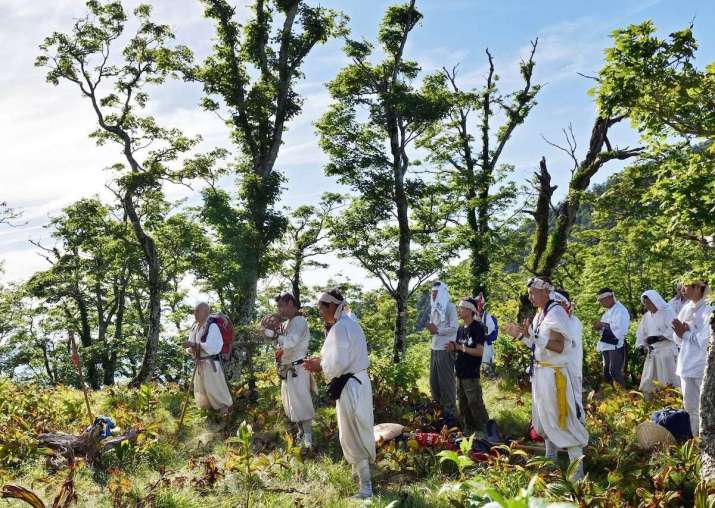 Praying at a nabiki along the Okugakemich. Photo by Banri Tanaka
Praying at a nabiki along the Okugakemich. Photo by Banri TanakaDuring the Heian period (794–1185), the teachings and practices of Esoteric Buddhism, in particular that of Tendai Buddhism, headquartered on Mount Hiei near Kyoto, and Shingon Buddhism, with its seat on Mount Koya, would amalgamate mountain worship, ancient shamanistic rituals, and local folk beliefs in Japan.
Toward the end of the 12th century and into the 13th century, these various spiritual practices and austerities became more organized and were referred to as Shugen. Temples and shrines sprung up in the mountains, religious centers gradually emerged, and nascent Shugen groups formed an association with a particular mountain area and a temple-shrine complex there. What is now referred to as Shugendo came into being.
During the Edo period (1603–1868) the Shugendo tradition and its practices spread to the common people. Inspired by the Shugenja, villagers began to engage in mountain ascetic activities and pilgrimages to sacred sites. They formed ko (lay believers associations) and the number of Shugendo followers grew steadily.
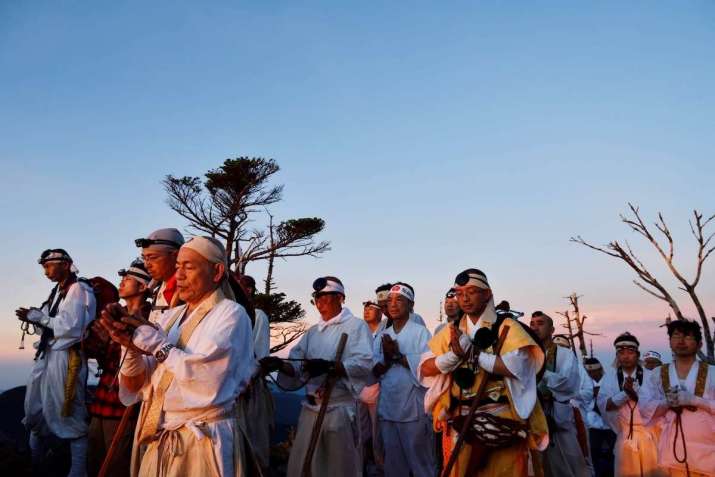 Prayer in the mountains is part of mountain entry practices, shown here by a group of Shugenja from Yoshino. Photo by Banri Tanaka
Prayer in the mountains is part of mountain entry practices, shown here by a group of Shugenja from Yoshino. Photo by Banri TanakaThe fall of Shugendo
This development came to an end with the Meiji Restoration of 1868, a revolution that ended the rule of the shogun and the samurai class and restored power to the emperor. Emperor Meiji sought to modernize the country, and in the process a law was passed that required the segregation of kami from buddhas (shinbutsu bunri), which meant a separation of Shinto shrines and Buddhist temples.
Since Shugendo had evolved into kami-buddha worship, and the place of worship was generally a temple-shrine complex, the base of the Shugendo tradition was thus threatened. What had been combined was now split, which forced Shugenja to become shrine priests, Buddhist monks, or to give up on the tradition altogether.
In 1872, Shugendo was banned altogether as it was considered backward, superstitious, and not in keeping with the development of a new Japan. Since then, only very few Shugendo centers were able to continue their activities, while most sites, groups, and networks ceased to exist.
After World War II, restrictions on religious activities were lifted and Shugenja were once again free to practice openly, however there were few “survivors.” There were very few places where the tradition seems to have been sustained without much loss, namely at Kimpusen-ji (Omine-san), a temple in the Yoshino area, and at Haguro-san, one of the Three Mountains of Dewa.
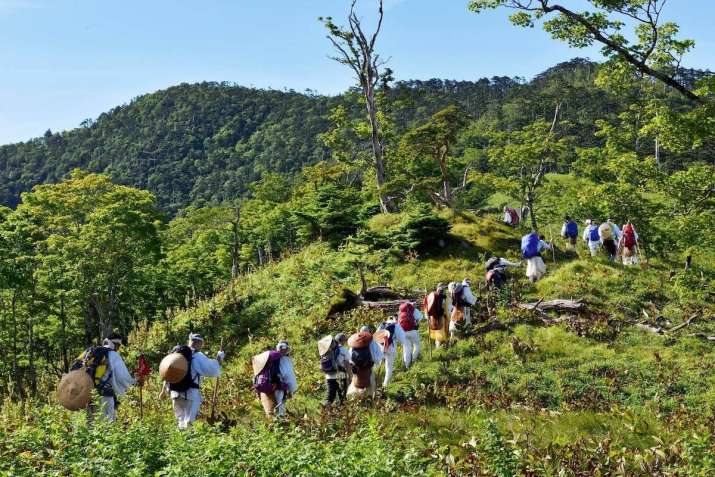 Annual pilgrimage on the Okugake trail by a Shugendo group from Yoshino. Photo by Banri Tanaka
Annual pilgrimage on the Okugake trail by a Shugendo group from Yoshino. Photo by Banri TanakaThe way of revival
For the reconstruction of a Shugendo tradition at a particular locality, what is generally needed are: committed practitioners, the re-transmission of practices, and the recovery of documents, physical places, and trails. Furthemore, a charismatic leader working with a local community, and specific local conditions coupled with trans-local networks are necessary.
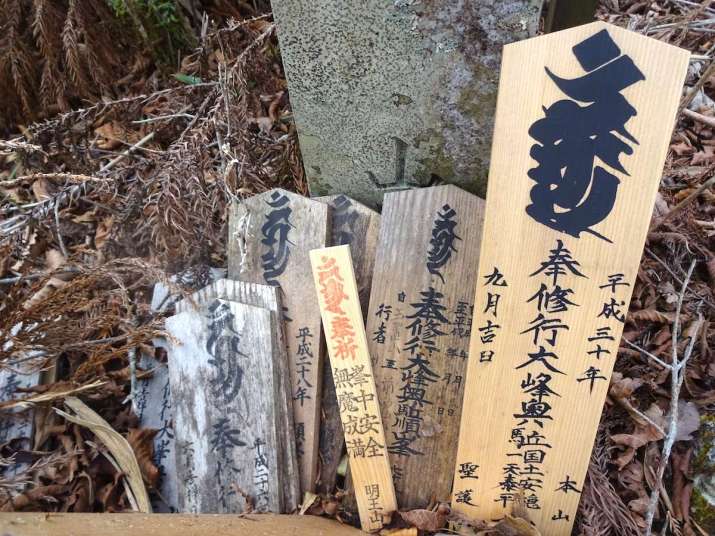 Shugenja leave fuda (wooden plaques) in the mountains as proof of their trek. Photo by Alena Eckelmann
Shugenja leave fuda (wooden plaques) in the mountains as proof of their trek. Photo by Alena EckelmannHow to become a yamabushi
Shugendo centers that were able to maintain their tradition are now able to send practitioners to sites that wish to restart their own traditions, and members of those communitiescan visit established Shugendo sites and connect to practitioners there.
People who wish to commit to becoming a yamabushi can undergo certain initiation rites and subscribe to yamabushi practices. Some practitioners receive tokudo ordination, in which a layperson is initiated and connected to their master. Those who received tokudo are then further initiated into various saho (rituals).
Nowadays there are only few practitioners who undertake long periods of training—of 21 days or 100 days, for example—while the majority enter the mountains for shugyo several times per year for a few days each time. Through each pilgrimage, mountain trek, and initiation, followers gain certain experiences. These experiences then aggregate and over years of training and some are accorded some kind of rank and eventually become sendatsu, leaders of Shugenja groups .
While some followers of Shugendo become ordained monks or priests, who continue to operate a Buddhist temple or a Shinto shrine, the majority remain ubasoku (lay practitioners), who often live in cities, work, and have families. Increasingly, women are now taking part in Shugendo training. Traditionally women were not allowed to enter sacred sites or to participate in Shugendo practices, but supported and facilitated training. Now there are opportunities to join training activities in the newly reconstituted groups.
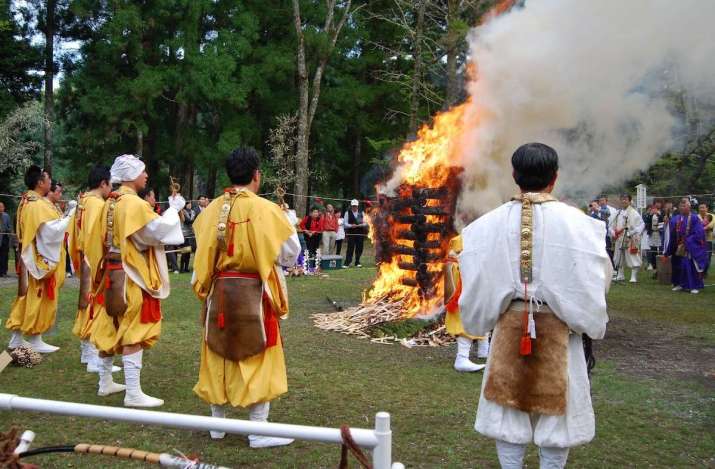 Saito goma underway in Hongu Town, part of spring celebrations at the Kumano Hongu Shrine. Photo by Alena Eckelmann
Saito goma underway in Hongu Town, part of spring celebrations at the Kumano Hongu Shrine. Photo by Alena EckelmannPractices: what yamabushi-to-be need to learn
Experienced practitioners from established Shugendo centers are able to bring their expertise in training and knowledge of ritual practices to communities and localities that seek to recover their lost tradition. The devotion of shugenja, then and now, is to shugyo (training), which typically takes place in certain mountain areas that are held to be sacred. Hence, any revival of practices would need to involve some kind of shugyo in the mountains.
The most common type of shugyo is nyubu (seasonal peak entries) and mineiri (ritual forms of mountain climbing) involving long and arduous mountain treks and prayer rites in the mountains. Other practices include kaihogyo (circling the mountain) and takigyo (ceremonial purification beneath waterfalls). All require considerable endurance and commitment, not to mention strength and fitness.
Learning to play the horagai, or to practice meditation and danjiki (periods of sleep and food deprivation) are also important aspects of training. Saito goma (ritual bonfires) and related rituals are a common sight and are often attended by locals and draw media attention.
These practical aspects of training do not themselves fully explain Shugendo, nor revive the tradition without considering the deeper meaning and symbolism of the practices and historical developments at a particular locality.
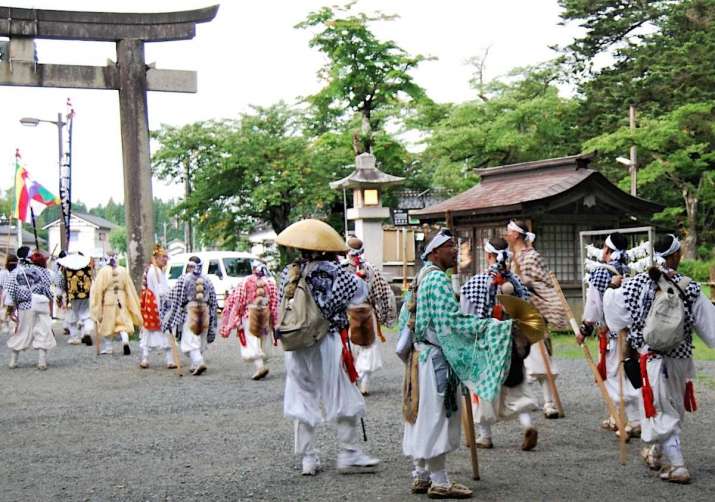 Shugenja of Haguro Shugendo on the last day of Autumn Peak training, a mountain entry rite. Photo by Alena Eckelmann
Shugenja of Haguro Shugendo on the last day of Autumn Peak training, a mountain entry rite. Photo by Alena EckelmannPlaces: former sites reconstructed
Since the 1980s, a number of former Shugendo sites have witnessed a revival. Instrumental in the reconstruction are the recovery of documents and artifacts and the revival of former training sites and trails, some of which have even received recognition as heritage sites.
Kumano Shugen, a Shugendo group in the Tendai lineage based at Nachisan Seigando-ji, a temple at Nachi Waterfall in Kumano, Wakayama Prefecture, celebrated their 33rd revival anniversary this year. The eighth chief abbot of the temple instigated the revival and initiated the reconstruction of the temple compound after he found a yamabushi costume in the chest of his late father while sorting his belongings.
Nachi is one of the Kumano Sanzan (Three Sacred Sites of Kumano), which is part of a UNESCO Word Heritage Site inscribed in 2004. Also a part is the Okugakemichi, a 170-kilometer Shugendo training trail that follows a mountain range, along which are 75 nabiki (prayer stations). The restoration of the southern part of the Okugakemichi was driven by Kumano Shugen and its local supporters, especially Shingu Yamabiko, a local mountaineering group.
Koshigidake is a mountain in the Murayama area of Yamagata Prefecture that has been worshipped as the seat of a deity since ancient times. Shugendo here was formerly centered on a village temple in the Shingon lineage. The tradition was abandoned during the Meiji period but was revived in 2005 by a direct descendent as Koryu Shugen Honshu. An extensive archive of Shugendo texts and Buddhist statues were secretly preserved and now help to revive the former practices and training locations. There are ritual manuals and a large collection of documents that testify to the roles of Shugendo practitioners in the villages at the base of Koshigidake.
Katsuragi is another mountain range, more than 100 kilometers long, stretching from Tomogashima in Wakayama Prefecture to Oji-cho in Nara Prefecture. Along its ridge lies another Shugendo training trail that has been revived in recent years, with 28 kyozuka (ancient sutra mounds) in the vicinity of waterfalls, megaliths, shrines, and temples, which are prayer stations on this trail. This is the training ground of Katsuragi Shugen, a group of Shugenja based in this area. In 2019, this historic Shugendo trail was certified as one of “100 Selected Historic Roads” in Japan, and this year, Katsuragi Shugen was awarded the status of National Heritage Site.
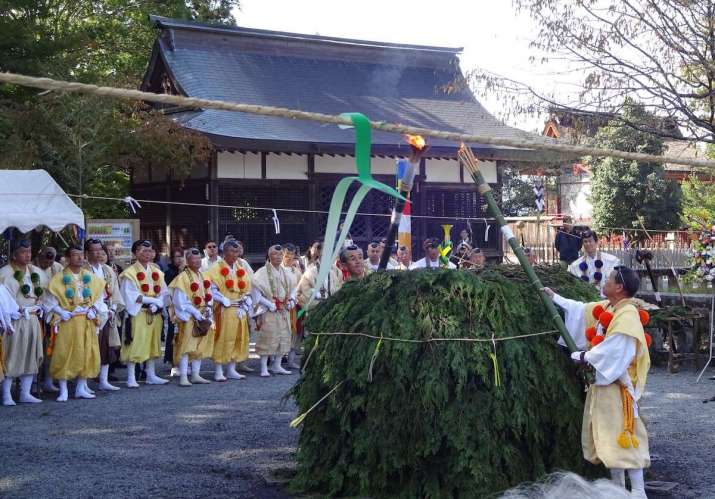 The beginning of a saito goma fire ceremony in Yoshino. Photo by Alena Eckelmann
The beginning of a saito goma fire ceremony in Yoshino. Photo by Alena EckelmannResearch is underway into developments at Togakushisan in Nagano Prefecture, Homanzan in Fukuoka Prefecture, and Hikosan in Oita Prefecture, three mountain areas that formerly had strong Shugendo traditions. There are also some revival efforts by independent practitioners and informal local groups, including one near Lake Biwa in Shiga Prefecture, and another in the Zao mountain range in Miyagi Prefecture.
The question beckons: what is the relevance of Shugendo in 21st century Japan? Why is there such an interest in a revival now? And what steps are taken toward reconstructing the tradition?
The majority of academic research focuses on historical rather than contemporary developments. Hence, there is no solid body of research yet for the following broad themes under which the revival of Shugendo can be investigated:
• A general trend in Japanese society toward eco-conscious, green, and sustainable living.
• Increasing interest among Japanese people in spiritual quests and visiting sacred sites and “power spots.”
• Support from governmental offices and tourism agents for the recovery of historical sites and trails.
• The influence of media publicity and of social media exposure.
The second part of this article will examine the revival trend in more detail by looking at case studies and by talking to Shugendo scholars and practitioners.
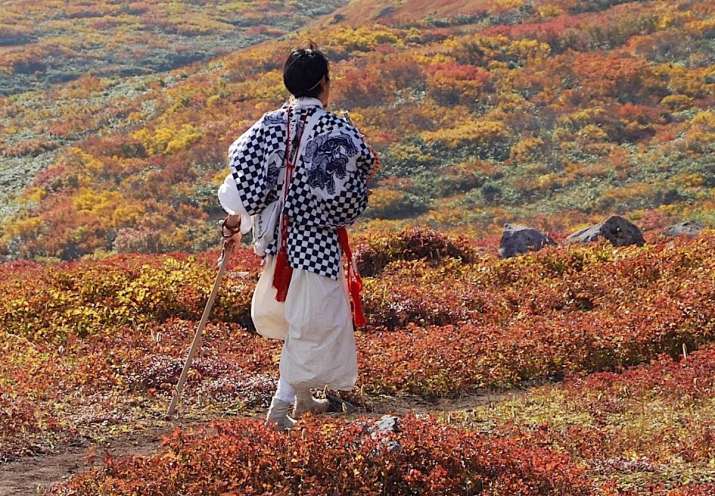 A Shugenja in the Haguro Shugendo tradition traversing Gassan, one of the Three Sacred Mountains of Dewa. Photo by Alena Eckelmann
A Shugenja in the Haguro Shugendo tradition traversing Gassan, one of the Three Sacred Mountains of Dewa. Photo by Alena EckelmannAlena Eckelmann is from east of the Wall and south of Berlin, in Germany. She holds an MA in Asian Studies from the School of Oriental and African Studies in London and an MA from Passau University in Germany. In 2005, Alena traveled to Tokyo under the EU-sponsored Executive Training Program and worked as assistant director for the Japan Market Expansion Competition. She has been writing about Japan since her days in Tokyo. In 2011, she moved to Kumano in the south of the Kii Peninsula to begin training with a Shugendo monk. In 2016, she received tokudo from Sakuramotobou Temple in Yoshino, where she continues her Shugendo training. She qualified as a licensed guide for the Kumano Kodo and Koyasan, and is a licensed forest therapy guide. Alena has a deep interest in the spirituality and nature of Japan, which she would like to share with the world.
Related features from Buddhistdoor Global
Connecting the Past and Present of Shugendo – The Revival of Japan’s Ancient Mountain Ascetic Tradition, Part Two
Connecting the Past and Present of Shugendo – The Revival of Japan’s Ancient Mountain Ascetic Tradition, Part Three
Connecting the Past and Present of Shugendo – The Revival of Japan’s Ancient Mountain Ascetic Tradition, Part Four
Connecting the Past and Present of Shugendo – The Revival of Japan’s Ancient Mountain Ascetic Tradition, Part Five
Related news reports from Buddhistdoor Global
Archaeologists Unearth Possible Fragments of the Largest Buddhist Pagoda Ever Built in Japan
Japan Seeks World Heritage Status for Country’s Oldest Buddhist Pilgrimage Route
Japanese Monk Completes Nine-day Doiri Retreat Without Food, Water, or Sleep














